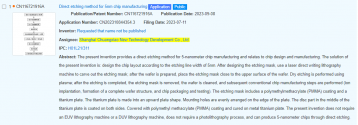looks like the keep here is to just keep diamond layer really thin (10 microns). Looks like they got all the basic tech down like 2-6 inch Diamond-on-Si wafer + oriented piezoelectric film preparation process and design of diamond-based RF filter
interesting, didn't know Henan produced 70% of world's super hard material
No kidding, Henan is capital of world's lab grown diamond production
so unlike the other stuff we talked about, this is still an experiment project. Will take a while longer for 960m RMB to all be invested in this. I'm also curious what other project they can do since diamond is considered 4th gen semi material
More on this
此外,科之诚创新了材料工艺,突破了“大面积高平整度金刚石薄膜沉积 C轴择优取向氮化铝薄膜沉积”,用SAW工艺和成本,实现了通信产业常用的BAW滤波器的产品性能。同频SAW滤波器约为同频BAW滤波器成本10%~20%,大幅降低了以手机为代表的通信产业的制造成本。
据了解,现有的高频滤波器芯片主要是在铌酸锂基片的基础上进行设计和开发,而金刚石基滤波器芯片使用同样的声表面波技术,能够使滤波器的滤波频率从sub-6G提升到6GHz-10GHz,大幅度降低2GHz--10GHz所采用的体波技术成本,并大幅增强高频滤波器芯片的可集成性。
The key to this technology is achieving SAW level cost for BAW level performance. Just 10-20% of BAW filter cost is needed here
And the frequency range has increased to include 6-10GHz.
Which to me seems like where 6G or even 5.5G frequencies will end up
China, with its 1160 megahertz of mid-band, is on a better pace to keep up with demand, and more in line with how
. This point is especially critical as we approach WRC-23 in the fall. The 6 GHz band China allocated for 5G (specifically 6425-7125 MHz) is being considered on a regional basis for 5G harmonization. China made this allocation explicitly because it is “conducive to promoting the consistency of global or regional” 5G technology in the band.
so the band they opened up for greater 5G (likely 5.5G) is in this range of 6.4 to 7.1GH which is currently not supported by any of the BAW filters
here are the current bands (you can see in this link)
Qualcomm supports filters from 5 to 7GHz
looks like Akoustis tech supports up to 7GHz also
so current tech is not ready to handle the upper end of the band that China has recently auctioned off.
Back to our diamond friend
公司计划投资9.6亿元,分三期建设金刚石基滤波器芯片产业化项目。”谢波玮说。
初期阶段,科之诚计划投资6000万元,推出行业对标产品,实现金刚石基高频滤波器大规模量产。
“中期阶段,计划投资3亿元,建设硅基金刚石、AIN多层膜晶圆线,并用代工方式生产芯片,同时启动科创板上市。”谢波玮说。
后期阶段,计划投资6亿元,建设滤波器芯片全工艺流程IDM线,打造第三代半导体产业集群。
Their 3 stage plan involves first getting diamond based BAW filter into mass production
2nd builds diamond & AlN wafer production line
3rd will involve becoming an IDM
“之所以会这样,主要源于材料和专利的限制。”谢波玮说,一方面,国内目前无法大规模生产制造滤波器芯片的材料——高品质电子级铌酸锂、钽酸锂单晶;另一方面,国外长期的发展已经形成了明确的专利壁垒。
也就是说,高频滤波器要真正实现国产,必须在芯片基础材料和技术专利上双双取得突破。
科之诚公司与中国科学院电工研究所经过8年的联合攻关,在基础材料领域提出了“金刚石+氮化铝”的材料体系,在电路设计方面全新设计了“螺旋结构的IDT换能电路”,最终推出了高频金刚石基射频滤波器产品,绕过了传统技术路线的专利限制,打破了国外在高频滤波器领域的垄断,填补了国内空白。
so there is an issue of material and patents that has kept China's BAW filter production down.
In this case, CAS and 科之诚公司 worked on this for 8 years to create this diamond based RF filter
科之诚 did well enough that it got Henan govt official to visit this month.
在河南科之诚第三代半导体碳基芯片有限公司,陶曼晞听取了企业负责人关于企业科研情况的汇报。据介绍,该公司突破了“大面积、高平整度金刚石薄膜沉积”“氮化铝多元素重掺杂、高平整度C轴择优取向薄膜”等技术难点,在基础材料领域提出了“金刚石+氮化铝的材料体系”;在电路设计方面提出了“全新设计的螺旋结构IDT换能电路”等创新技术,推出的2GHz--10GHz高频金刚石基射频滤波器产品,打破了国外在高频滤波器领域的垄断,填补了国内空白。
Looks like aside from 2-10GHz diamond rf filter, they also got this newly designed spiral structure IDT transducer circuit
looks like it just got A+ round funding


